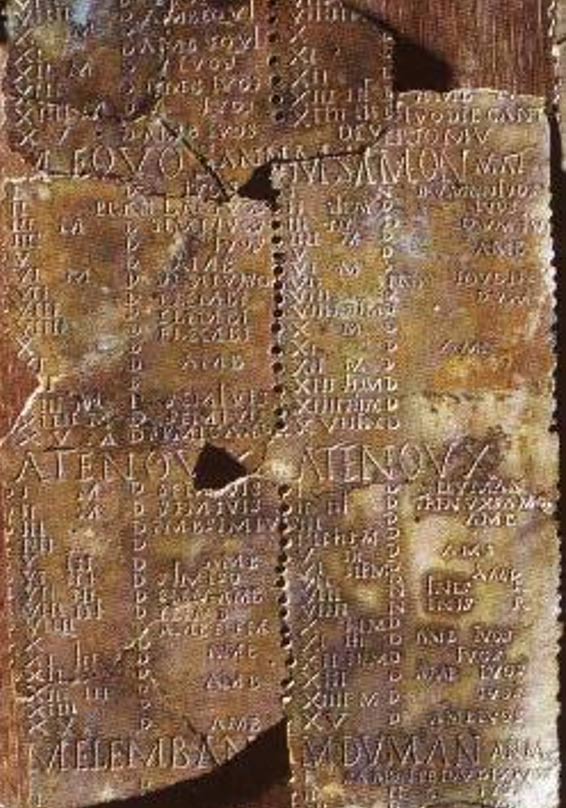
Coligny Calendar: The 1,800-Year-Old Lunisolar calendar banned by the Romans
In 1897, the Gaulish Coligny Calendar was discovered in Coligny, Ain, France. The bronze calendar was found broken into 73 pieces, which together form a 5 foot wide, 3.5 foot high bronze tablet. When assembled, it displays a lunisolar calendar, which follows both moon phases and the time of solar year. It is believed that the calendar, dating back to the 2 nd century AD, had been banned by the Romans as it indicated druidic practices. The calendar can now be found at the Gallo-Roman Museum of Lyon.

Map of France showing location of Coligny (Wikipedia)
The age of the calendar has been estimated based upon the styling of the letters and images it contains. French archaeologist, J. Monard, has speculated that the druids created the calendar as a means of preserving the druid tradition of timekeeping at a time when the Julian calendar was being heavily promoted throughout the Roman Empire. Druid were members of the educated, professional class among the Celtic peoples of Gaul, Britain, Ireland, and possibly elsewhere during the Iron Age. The druid class included law-speakers, poets and doctors, among other learned professions, although the best known among the druids were the religious leaders.

Imaginative illustration of 'An Arch Druid in His Judicial Habit', from "The Costume of the Original Inhabitants of the British Islands" by S.R. Meyrick and C.H. Smith (1815), the gold gorget collar copying Irish Bronze Age examples. (Wikimedia Commons)
A calendar similar to the Coligny calendar was found nearby at Villards d'Heria. Both calendars follow the Contintental Celtic calendar. Through reconstruction, researchers have been able to determine that the calendar is a lunisolar calendar, focusing on the lunar month and the solar year. Scholars have disagreed as to whether a new month began with the new moon, full moon, or the first quarter moon. The lunar year was made up of 354 or 355 days. There is dispute as to whether the calendar began in summer or autumn. The starting month, Samonios, is generally affiliated with Old Irish Samhain on October 31. However, Samon is Gaulish for summer.
Like the modern calendar, the Coligny calendar is comprised of 12 months, with each month containing 29-30 days. The months include:
|
Month |
Time Period |
Meaning |
Days |
|
Samonios |
October - November |
Seed-fall |
30 |
|
Dumannios |
November - December |
The Darkest Depths |
29 |
|
Riuros |
December - January |
Cold-time |
30 |
|
Anagantios |
January - February |
Stay-home-time |
29 |
|
Ogronios |
February - March |
Time of Ice |
30 |
|
Cutios |
March - April |
Time of Winds |
30 |
|
Giamonios |
April - May |
Shoots-show |
29 |
|
Simivisionios |
May - June |
Time of Brightness |
30 |
|
Equos |
June - July |
Horse-time |
29/30 |
|
Elembiuos |
July - August |
Claim-time |
29 |
|
Edrinios |
August - September |
Arbitration-time |
30 |
|
Cantios |
September - October |
Song-time |
20 |
|
Sonnocingos - |
Intercalary |
"Sun's march" |
30 |
To follow the solar year, the 13 th intercalary month, referred to as Sonnocingos, was included every 2.5 years. The intercalary month alternated between being inserted before Samonios and being inserted in between Cutios and Giamonios. Each month into the calendar was divided into halves, with the second half serving as an atenoux or “renewal.” The two halves were also known as the “light” half and the “dark” half, following the new moon, and indicating that it had some religious significance. Overall, the calendar followed thirty-year periods, split into smaller five-month segments. Each five-month segment contained 62 months, including the intercalary months. According to some researchers, this cycling creates an error in following the moon cycles.

Segment from the Coligny calendar (lila.sns.it)
The Coligny calendar provides insight into how some viewed the world, moon cycles, and sun cycles during ancient times. At the time when it was created, the Julian calendar was being imposed throughout the Roman Empire. The discovery of the Coligny Calendar shows how others viewed and measured the passage of time, days, months, and years. Although calendaring has changed over time, it is clear that one thing has not changed – the use of moon phases and the Earth’s revolution around the sun to measure the passage of time.
Featured image: Image source: http://upload.wikimedia.org/wikipedia/commons/2/26/Coligny.jpg
Sources:
Coligny Calendar – Wikipedia. Available from: http://en.wikipedia.org/wiki/Coligny_calendar
The Coligny Tablet – Roman Britain. Available from: http://www.roman-britain.org/celtic/coligny.htm
The Gaulish (Coligny) Calendar – Time Meddler. Available from: http://www.time-meddler.co.uk/gaulish.html
By M R Reese
















Comments
I'm interested in my ancestors history and the subjects are related to my research as a student of Celtic ancient culture and related.
a lunar calendar follows the moon phases, hence about 28 days not the number they claim. if it did, it would be as inaccurate as our calendar today is in regards to the moon phases anyway. in any event the calendar , current or otherwise is completely inaccurate. we add a day every 4 years BUT it actually takes 365.256 days for the earth to revolve around the sun. thus every 1000 years is off by 6 days meaning as of right now our calendar is off by about 12 days
The article states: "the calendar followed thirty-year periods, split into smaller five-month segments. Each five-month segment contained 62 months"
I believe the references to 'five-month' segments should instead be 'five-YEAR' segments. As it stands, it makes no sense at all.
Stay-home-time in February.. No wonder it's the biggest time for some lovin'
Too bad they couldn't have just meshed the two calendars together somehow and make a super calendar.
Peace and Love,
Ricky.
Pages